Analysis of He Korowai Oranga: Maori Health Strategy Report
VerifiedAdded on 2023/01/17
|12
|2554
|69
Report
AI Summary
This report provides a detailed analysis of the He Korowai Oranga: Maori Health Strategy, focusing on its aims, target groups (iwi, hapu, whanau, and Maori), and rationale. It examines how the strategy aligns with the New Zealand Health Strategy 2016, highlighting key areas of support and integration. The report also explores a significant health initiative, namely the establishment of Maori healthcare providers, and discusses how this initiative contributes to improved health outcomes for the target groups. The analysis includes an overview of the historical context, the challenges faced by the Maori population, and the government's efforts to address health disparities. The report concludes by emphasizing the importance of the He Korowai Oranga strategy in directing Maori health services and improving health outcomes, as supported by the initiative of Maori healthcare providers. The report is a valuable resource for understanding the complexities of Maori health and the strategies employed to improve it.

Running head: HE KOROWAI ORANGA: MAORI HEALTH STRATEGY 1
He Korowai Oranga: Maori Health Strategy
Student’s Name
Institutional Affiliation
He Korowai Oranga: Maori Health Strategy
Student’s Name
Institutional Affiliation
Paraphrase This Document
Need a fresh take? Get an instant paraphrase of this document with our AI Paraphraser

HE KOROWAI ORANGA: MAORI HEALTH STRATEGY 2
Executive Summary
This paper focuses on the discussion of He Korowai Oranga a Maori health strategy that is
expected to enhance the planning and improvement of the Maori health status. This strategy is
also expected to support the government, Ministry of health, Maori ethnic groups, and other
health care providers based on the strategic development of healthcare services. A diagram is
provided that seeks to summarize the details about the He Korowai Oranga based on the aims,
target groups, and rationale. Further, this strategy aligns with the aims of the New Zealand
Health Strategy 2016 in various ways. The establishment of the Maori healthcare providers is a
significant initiative that contributes towards the achievement of He Korowai Oranga as outlined
in this report. Lastly, the initiative plays a significant way towards supporting the improved
health results among the mentioned target groups such as iwi, hapu, whanau, and Maori.
Executive Summary
This paper focuses on the discussion of He Korowai Oranga a Maori health strategy that is
expected to enhance the planning and improvement of the Maori health status. This strategy is
also expected to support the government, Ministry of health, Maori ethnic groups, and other
health care providers based on the strategic development of healthcare services. A diagram is
provided that seeks to summarize the details about the He Korowai Oranga based on the aims,
target groups, and rationale. Further, this strategy aligns with the aims of the New Zealand
Health Strategy 2016 in various ways. The establishment of the Maori healthcare providers is a
significant initiative that contributes towards the achievement of He Korowai Oranga as outlined
in this report. Lastly, the initiative plays a significant way towards supporting the improved
health results among the mentioned target groups such as iwi, hapu, whanau, and Maori.

HE KOROWAI ORANGA: MAORI HEALTH STRATEGY 3
Contents
Executive Summary.....................................................................................................................................2
Introduction.................................................................................................................................................4
Aims, Target Group and Rationale for the Strategy.....................................................................................4
Ways in Which the Strategy Supports or Aligns To the Aims of the New Zealand Health Strategy 2016....6
One Health Initiative which is or Has Been Implemented to Support Achievement of the Strategy...........7
Ways in Which the Initiative Supports Improved Health Outcomes for the Target Group..........................8
Conclusion...................................................................................................................................................9
References.................................................................................................................................................10
Contents
Executive Summary.....................................................................................................................................2
Introduction.................................................................................................................................................4
Aims, Target Group and Rationale for the Strategy.....................................................................................4
Ways in Which the Strategy Supports or Aligns To the Aims of the New Zealand Health Strategy 2016....6
One Health Initiative which is or Has Been Implemented to Support Achievement of the Strategy...........7
Ways in Which the Initiative Supports Improved Health Outcomes for the Target Group..........................8
Conclusion...................................................................................................................................................9
References.................................................................................................................................................10
⊘ This is a preview!⊘
Do you want full access?
Subscribe today to unlock all pages.

Trusted by 1+ million students worldwide
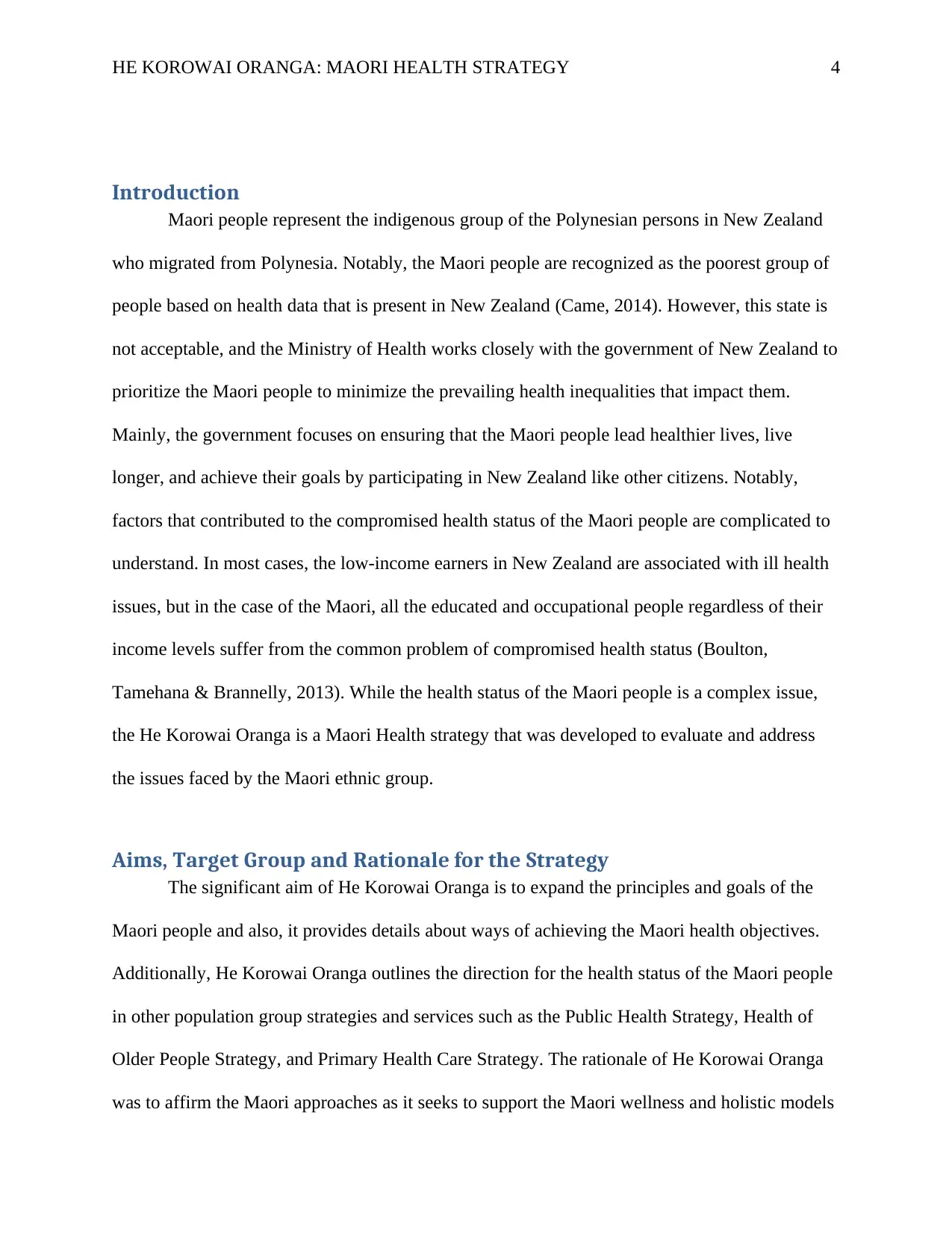
HE KOROWAI ORANGA: MAORI HEALTH STRATEGY 4
Introduction
Maori people represent the indigenous group of the Polynesian persons in New Zealand
who migrated from Polynesia. Notably, the Maori people are recognized as the poorest group of
people based on health data that is present in New Zealand (Came, 2014). However, this state is
not acceptable, and the Ministry of Health works closely with the government of New Zealand to
prioritize the Maori people to minimize the prevailing health inequalities that impact them.
Mainly, the government focuses on ensuring that the Maori people lead healthier lives, live
longer, and achieve their goals by participating in New Zealand like other citizens. Notably,
factors that contributed to the compromised health status of the Maori people are complicated to
understand. In most cases, the low-income earners in New Zealand are associated with ill health
issues, but in the case of the Maori, all the educated and occupational people regardless of their
income levels suffer from the common problem of compromised health status (Boulton,
Tamehana & Brannelly, 2013). While the health status of the Maori people is a complex issue,
the He Korowai Oranga is a Maori Health strategy that was developed to evaluate and address
the issues faced by the Maori ethnic group.
Aims, Target Group and Rationale for the Strategy
The significant aim of He Korowai Oranga is to expand the principles and goals of the
Maori people and also, it provides details about ways of achieving the Maori health objectives.
Additionally, He Korowai Oranga outlines the direction for the health status of the Maori people
in other population group strategies and services such as the Public Health Strategy, Health of
Older People Strategy, and Primary Health Care Strategy. The rationale of He Korowai Oranga
was to affirm the Maori approaches as it seeks to support the Maori wellness and holistic models
Introduction
Maori people represent the indigenous group of the Polynesian persons in New Zealand
who migrated from Polynesia. Notably, the Maori people are recognized as the poorest group of
people based on health data that is present in New Zealand (Came, 2014). However, this state is
not acceptable, and the Ministry of Health works closely with the government of New Zealand to
prioritize the Maori people to minimize the prevailing health inequalities that impact them.
Mainly, the government focuses on ensuring that the Maori people lead healthier lives, live
longer, and achieve their goals by participating in New Zealand like other citizens. Notably,
factors that contributed to the compromised health status of the Maori people are complicated to
understand. In most cases, the low-income earners in New Zealand are associated with ill health
issues, but in the case of the Maori, all the educated and occupational people regardless of their
income levels suffer from the common problem of compromised health status (Boulton,
Tamehana & Brannelly, 2013). While the health status of the Maori people is a complex issue,
the He Korowai Oranga is a Maori Health strategy that was developed to evaluate and address
the issues faced by the Maori ethnic group.
Aims, Target Group and Rationale for the Strategy
The significant aim of He Korowai Oranga is to expand the principles and goals of the
Maori people and also, it provides details about ways of achieving the Maori health objectives.
Additionally, He Korowai Oranga outlines the direction for the health status of the Maori people
in other population group strategies and services such as the Public Health Strategy, Health of
Older People Strategy, and Primary Health Care Strategy. The rationale of He Korowai Oranga
was to affirm the Maori approaches as it seeks to support the Maori wellness and holistic models
Paraphrase This Document
Need a fresh take? Get an instant paraphrase of this document with our AI Paraphraser
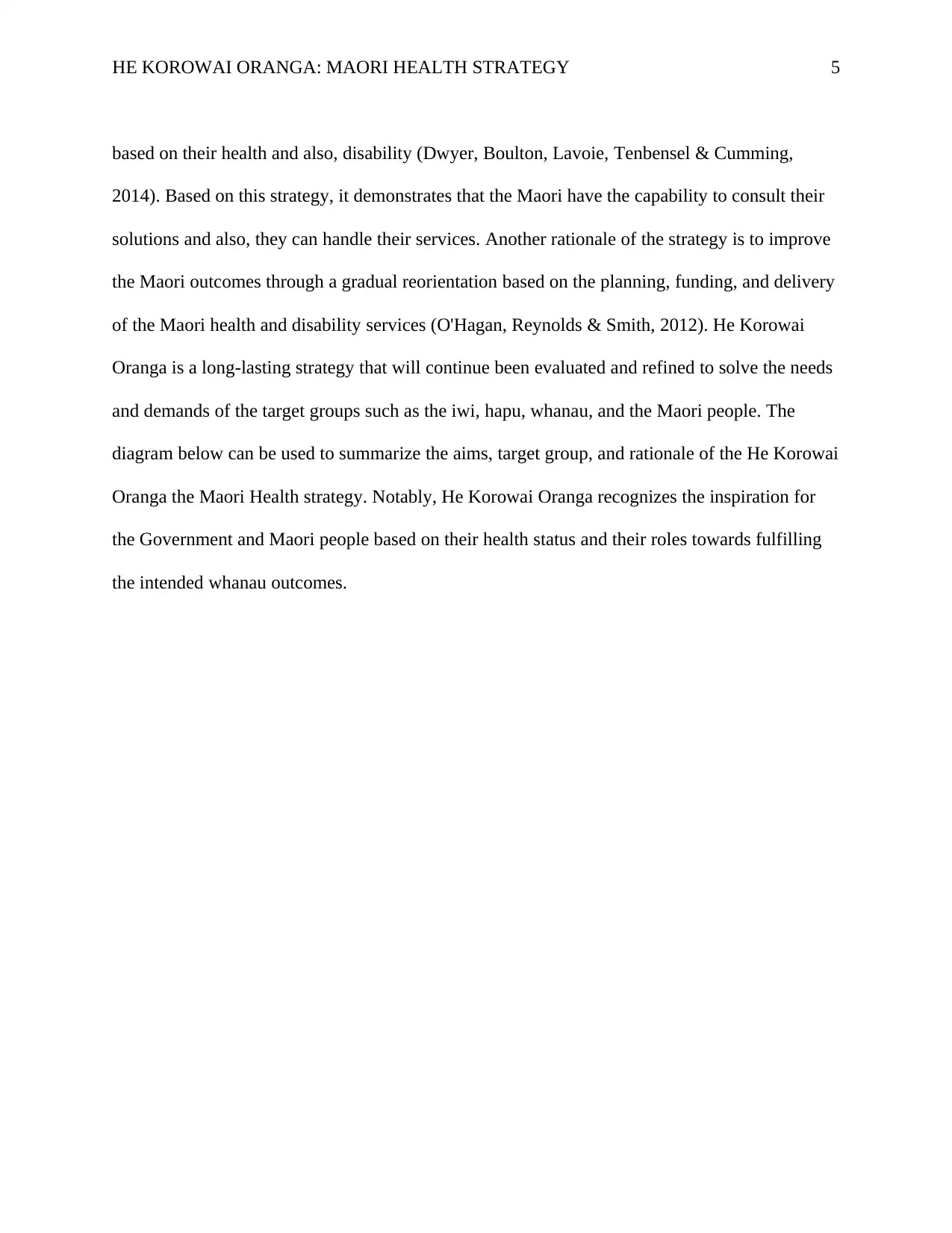
HE KOROWAI ORANGA: MAORI HEALTH STRATEGY 5
based on their health and also, disability (Dwyer, Boulton, Lavoie, Tenbensel & Cumming,
2014). Based on this strategy, it demonstrates that the Maori have the capability to consult their
solutions and also, they can handle their services. Another rationale of the strategy is to improve
the Maori outcomes through a gradual reorientation based on the planning, funding, and delivery
of the Maori health and disability services (O'Hagan, Reynolds & Smith, 2012). He Korowai
Oranga is a long-lasting strategy that will continue been evaluated and refined to solve the needs
and demands of the target groups such as the iwi, hapu, whanau, and the Maori people. The
diagram below can be used to summarize the aims, target group, and rationale of the He Korowai
Oranga the Maori Health strategy. Notably, He Korowai Oranga recognizes the inspiration for
the Government and Maori people based on their health status and their roles towards fulfilling
the intended whanau outcomes.
based on their health and also, disability (Dwyer, Boulton, Lavoie, Tenbensel & Cumming,
2014). Based on this strategy, it demonstrates that the Maori have the capability to consult their
solutions and also, they can handle their services. Another rationale of the strategy is to improve
the Maori outcomes through a gradual reorientation based on the planning, funding, and delivery
of the Maori health and disability services (O'Hagan, Reynolds & Smith, 2012). He Korowai
Oranga is a long-lasting strategy that will continue been evaluated and refined to solve the needs
and demands of the target groups such as the iwi, hapu, whanau, and the Maori people. The
diagram below can be used to summarize the aims, target group, and rationale of the He Korowai
Oranga the Maori Health strategy. Notably, He Korowai Oranga recognizes the inspiration for
the Government and Maori people based on their health status and their roles towards fulfilling
the intended whanau outcomes.
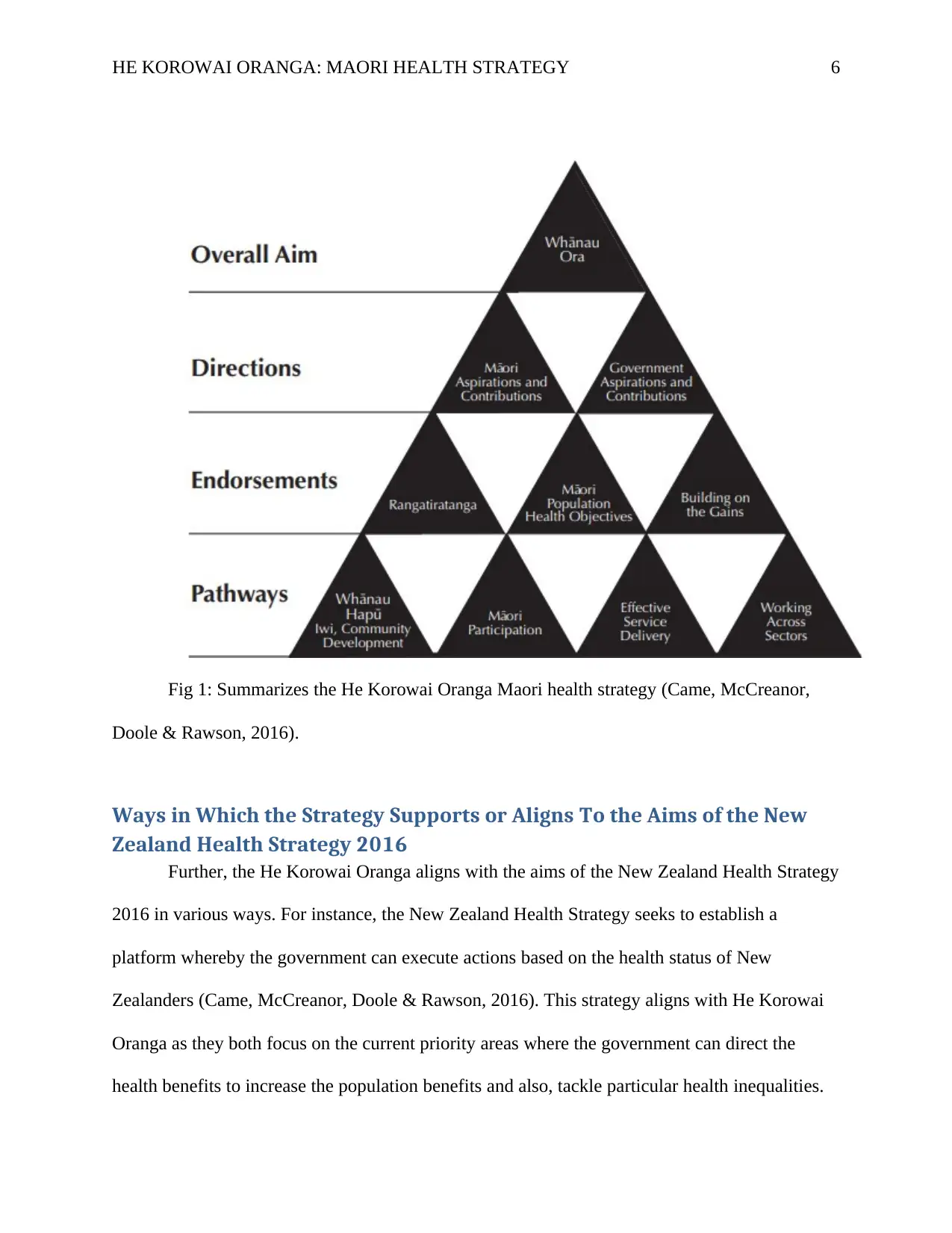
HE KOROWAI ORANGA: MAORI HEALTH STRATEGY 6
Fig 1: Summarizes the He Korowai Oranga Maori health strategy (Came, McCreanor,
Doole & Rawson, 2016).
Ways in Which the Strategy Supports or Aligns To the Aims of the New
Zealand Health Strategy 2016
Further, the He Korowai Oranga aligns with the aims of the New Zealand Health Strategy
2016 in various ways. For instance, the New Zealand Health Strategy seeks to establish a
platform whereby the government can execute actions based on the health status of New
Zealanders (Came, McCreanor, Doole & Rawson, 2016). This strategy aligns with He Korowai
Oranga as they both focus on the current priority areas where the government can direct the
health benefits to increase the population benefits and also, tackle particular health inequalities.
Fig 1: Summarizes the He Korowai Oranga Maori health strategy (Came, McCreanor,
Doole & Rawson, 2016).
Ways in Which the Strategy Supports or Aligns To the Aims of the New
Zealand Health Strategy 2016
Further, the He Korowai Oranga aligns with the aims of the New Zealand Health Strategy
2016 in various ways. For instance, the New Zealand Health Strategy seeks to establish a
platform whereby the government can execute actions based on the health status of New
Zealanders (Came, McCreanor, Doole & Rawson, 2016). This strategy aligns with He Korowai
Oranga as they both focus on the current priority areas where the government can direct the
health benefits to increase the population benefits and also, tackle particular health inequalities.
⊘ This is a preview!⊘
Do you want full access?
Subscribe today to unlock all pages.

Trusted by 1+ million students worldwide
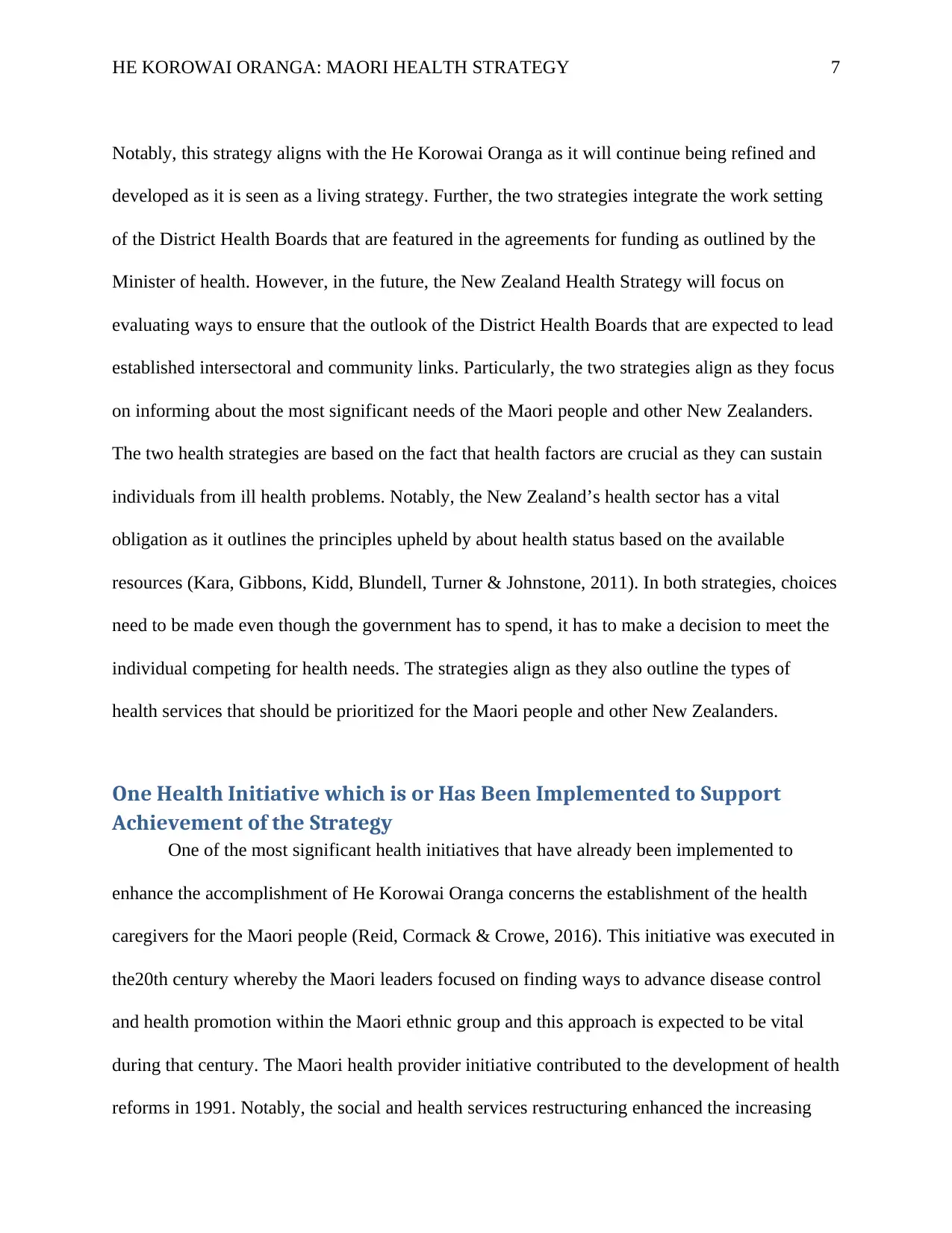
HE KOROWAI ORANGA: MAORI HEALTH STRATEGY 7
Notably, this strategy aligns with the He Korowai Oranga as it will continue being refined and
developed as it is seen as a living strategy. Further, the two strategies integrate the work setting
of the District Health Boards that are featured in the agreements for funding as outlined by the
Minister of health. However, in the future, the New Zealand Health Strategy will focus on
evaluating ways to ensure that the outlook of the District Health Boards that are expected to lead
established intersectoral and community links. Particularly, the two strategies align as they focus
on informing about the most significant needs of the Maori people and other New Zealanders.
The two health strategies are based on the fact that health factors are crucial as they can sustain
individuals from ill health problems. Notably, the New Zealand’s health sector has a vital
obligation as it outlines the principles upheld by about health status based on the available
resources (Kara, Gibbons, Kidd, Blundell, Turner & Johnstone, 2011). In both strategies, choices
need to be made even though the government has to spend, it has to make a decision to meet the
individual competing for health needs. The strategies align as they also outline the types of
health services that should be prioritized for the Maori people and other New Zealanders.
One Health Initiative which is or Has Been Implemented to Support
Achievement of the Strategy
One of the most significant health initiatives that have already been implemented to
enhance the accomplishment of He Korowai Oranga concerns the establishment of the health
caregivers for the Maori people (Reid, Cormack & Crowe, 2016). This initiative was executed in
the20th century whereby the Maori leaders focused on finding ways to advance disease control
and health promotion within the Maori ethnic group and this approach is expected to be vital
during that century. The Maori health provider initiative contributed to the development of health
reforms in 1991. Notably, the social and health services restructuring enhanced the increasing
Notably, this strategy aligns with the He Korowai Oranga as it will continue being refined and
developed as it is seen as a living strategy. Further, the two strategies integrate the work setting
of the District Health Boards that are featured in the agreements for funding as outlined by the
Minister of health. However, in the future, the New Zealand Health Strategy will focus on
evaluating ways to ensure that the outlook of the District Health Boards that are expected to lead
established intersectoral and community links. Particularly, the two strategies align as they focus
on informing about the most significant needs of the Maori people and other New Zealanders.
The two health strategies are based on the fact that health factors are crucial as they can sustain
individuals from ill health problems. Notably, the New Zealand’s health sector has a vital
obligation as it outlines the principles upheld by about health status based on the available
resources (Kara, Gibbons, Kidd, Blundell, Turner & Johnstone, 2011). In both strategies, choices
need to be made even though the government has to spend, it has to make a decision to meet the
individual competing for health needs. The strategies align as they also outline the types of
health services that should be prioritized for the Maori people and other New Zealanders.
One Health Initiative which is or Has Been Implemented to Support
Achievement of the Strategy
One of the most significant health initiatives that have already been implemented to
enhance the accomplishment of He Korowai Oranga concerns the establishment of the health
caregivers for the Maori people (Reid, Cormack & Crowe, 2016). This initiative was executed in
the20th century whereby the Maori leaders focused on finding ways to advance disease control
and health promotion within the Maori ethnic group and this approach is expected to be vital
during that century. The Maori health provider initiative contributed to the development of health
reforms in 1991. Notably, the social and health services restructuring enhanced the increasing
Paraphrase This Document
Need a fresh take? Get an instant paraphrase of this document with our AI Paraphraser
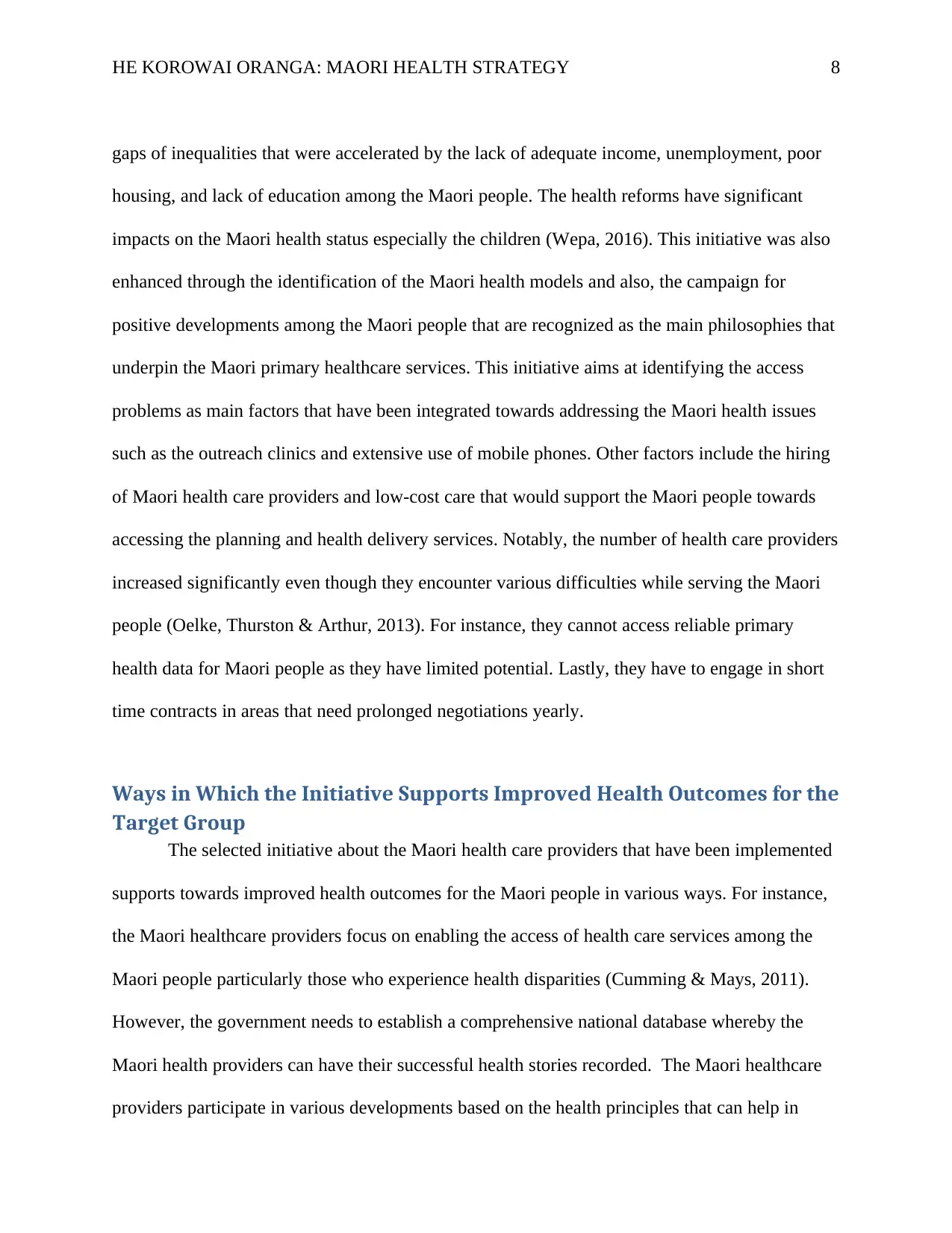
HE KOROWAI ORANGA: MAORI HEALTH STRATEGY 8
gaps of inequalities that were accelerated by the lack of adequate income, unemployment, poor
housing, and lack of education among the Maori people. The health reforms have significant
impacts on the Maori health status especially the children (Wepa, 2016). This initiative was also
enhanced through the identification of the Maori health models and also, the campaign for
positive developments among the Maori people that are recognized as the main philosophies that
underpin the Maori primary healthcare services. This initiative aims at identifying the access
problems as main factors that have been integrated towards addressing the Maori health issues
such as the outreach clinics and extensive use of mobile phones. Other factors include the hiring
of Maori health care providers and low-cost care that would support the Maori people towards
accessing the planning and health delivery services. Notably, the number of health care providers
increased significantly even though they encounter various difficulties while serving the Maori
people (Oelke, Thurston & Arthur, 2013). For instance, they cannot access reliable primary
health data for Maori people as they have limited potential. Lastly, they have to engage in short
time contracts in areas that need prolonged negotiations yearly.
Ways in Which the Initiative Supports Improved Health Outcomes for the
Target Group
The selected initiative about the Maori health care providers that have been implemented
supports towards improved health outcomes for the Maori people in various ways. For instance,
the Maori healthcare providers focus on enabling the access of health care services among the
Maori people particularly those who experience health disparities (Cumming & Mays, 2011).
However, the government needs to establish a comprehensive national database whereby the
Maori health providers can have their successful health stories recorded. The Maori healthcare
providers participate in various developments based on the health principles that can help in
gaps of inequalities that were accelerated by the lack of adequate income, unemployment, poor
housing, and lack of education among the Maori people. The health reforms have significant
impacts on the Maori health status especially the children (Wepa, 2016). This initiative was also
enhanced through the identification of the Maori health models and also, the campaign for
positive developments among the Maori people that are recognized as the main philosophies that
underpin the Maori primary healthcare services. This initiative aims at identifying the access
problems as main factors that have been integrated towards addressing the Maori health issues
such as the outreach clinics and extensive use of mobile phones. Other factors include the hiring
of Maori health care providers and low-cost care that would support the Maori people towards
accessing the planning and health delivery services. Notably, the number of health care providers
increased significantly even though they encounter various difficulties while serving the Maori
people (Oelke, Thurston & Arthur, 2013). For instance, they cannot access reliable primary
health data for Maori people as they have limited potential. Lastly, they have to engage in short
time contracts in areas that need prolonged negotiations yearly.
Ways in Which the Initiative Supports Improved Health Outcomes for the
Target Group
The selected initiative about the Maori health care providers that have been implemented
supports towards improved health outcomes for the Maori people in various ways. For instance,
the Maori healthcare providers focus on enabling the access of health care services among the
Maori people particularly those who experience health disparities (Cumming & Mays, 2011).
However, the government needs to establish a comprehensive national database whereby the
Maori health providers can have their successful health stories recorded. The Maori healthcare
providers participate in various developments based on the health principles that can help in
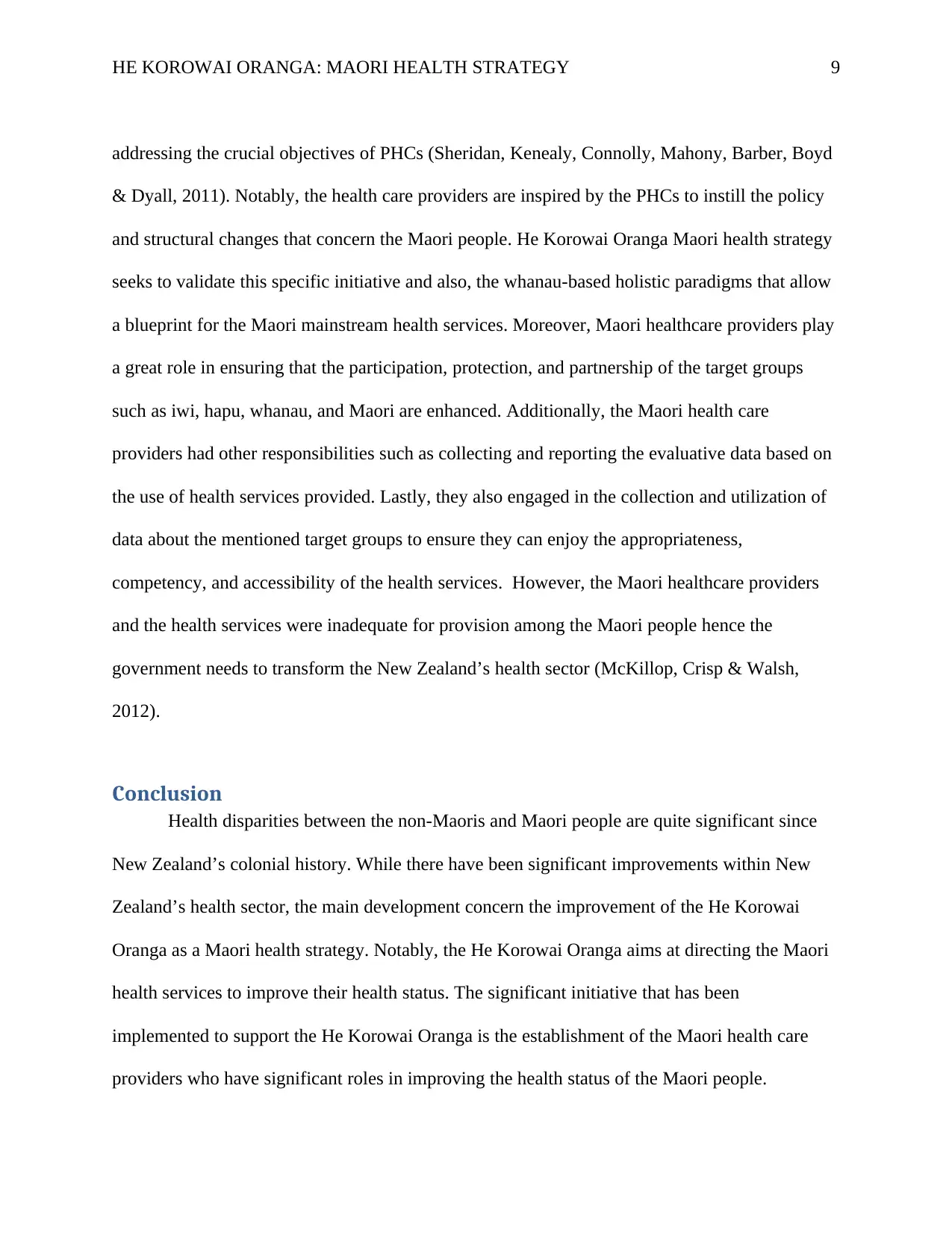
HE KOROWAI ORANGA: MAORI HEALTH STRATEGY 9
addressing the crucial objectives of PHCs (Sheridan, Kenealy, Connolly, Mahony, Barber, Boyd
& Dyall, 2011). Notably, the health care providers are inspired by the PHCs to instill the policy
and structural changes that concern the Maori people. He Korowai Oranga Maori health strategy
seeks to validate this specific initiative and also, the whanau-based holistic paradigms that allow
a blueprint for the Maori mainstream health services. Moreover, Maori healthcare providers play
a great role in ensuring that the participation, protection, and partnership of the target groups
such as iwi, hapu, whanau, and Maori are enhanced. Additionally, the Maori health care
providers had other responsibilities such as collecting and reporting the evaluative data based on
the use of health services provided. Lastly, they also engaged in the collection and utilization of
data about the mentioned target groups to ensure they can enjoy the appropriateness,
competency, and accessibility of the health services. However, the Maori healthcare providers
and the health services were inadequate for provision among the Maori people hence the
government needs to transform the New Zealand’s health sector (McKillop, Crisp & Walsh,
2012).
Conclusion
Health disparities between the non-Maoris and Maori people are quite significant since
New Zealand’s colonial history. While there have been significant improvements within New
Zealand’s health sector, the main development concern the improvement of the He Korowai
Oranga as a Maori health strategy. Notably, the He Korowai Oranga aims at directing the Maori
health services to improve their health status. The significant initiative that has been
implemented to support the He Korowai Oranga is the establishment of the Maori health care
providers who have significant roles in improving the health status of the Maori people.
addressing the crucial objectives of PHCs (Sheridan, Kenealy, Connolly, Mahony, Barber, Boyd
& Dyall, 2011). Notably, the health care providers are inspired by the PHCs to instill the policy
and structural changes that concern the Maori people. He Korowai Oranga Maori health strategy
seeks to validate this specific initiative and also, the whanau-based holistic paradigms that allow
a blueprint for the Maori mainstream health services. Moreover, Maori healthcare providers play
a great role in ensuring that the participation, protection, and partnership of the target groups
such as iwi, hapu, whanau, and Maori are enhanced. Additionally, the Maori health care
providers had other responsibilities such as collecting and reporting the evaluative data based on
the use of health services provided. Lastly, they also engaged in the collection and utilization of
data about the mentioned target groups to ensure they can enjoy the appropriateness,
competency, and accessibility of the health services. However, the Maori healthcare providers
and the health services were inadequate for provision among the Maori people hence the
government needs to transform the New Zealand’s health sector (McKillop, Crisp & Walsh,
2012).
Conclusion
Health disparities between the non-Maoris and Maori people are quite significant since
New Zealand’s colonial history. While there have been significant improvements within New
Zealand’s health sector, the main development concern the improvement of the He Korowai
Oranga as a Maori health strategy. Notably, the He Korowai Oranga aims at directing the Maori
health services to improve their health status. The significant initiative that has been
implemented to support the He Korowai Oranga is the establishment of the Maori health care
providers who have significant roles in improving the health status of the Maori people.
⊘ This is a preview!⊘
Do you want full access?
Subscribe today to unlock all pages.

Trusted by 1+ million students worldwide
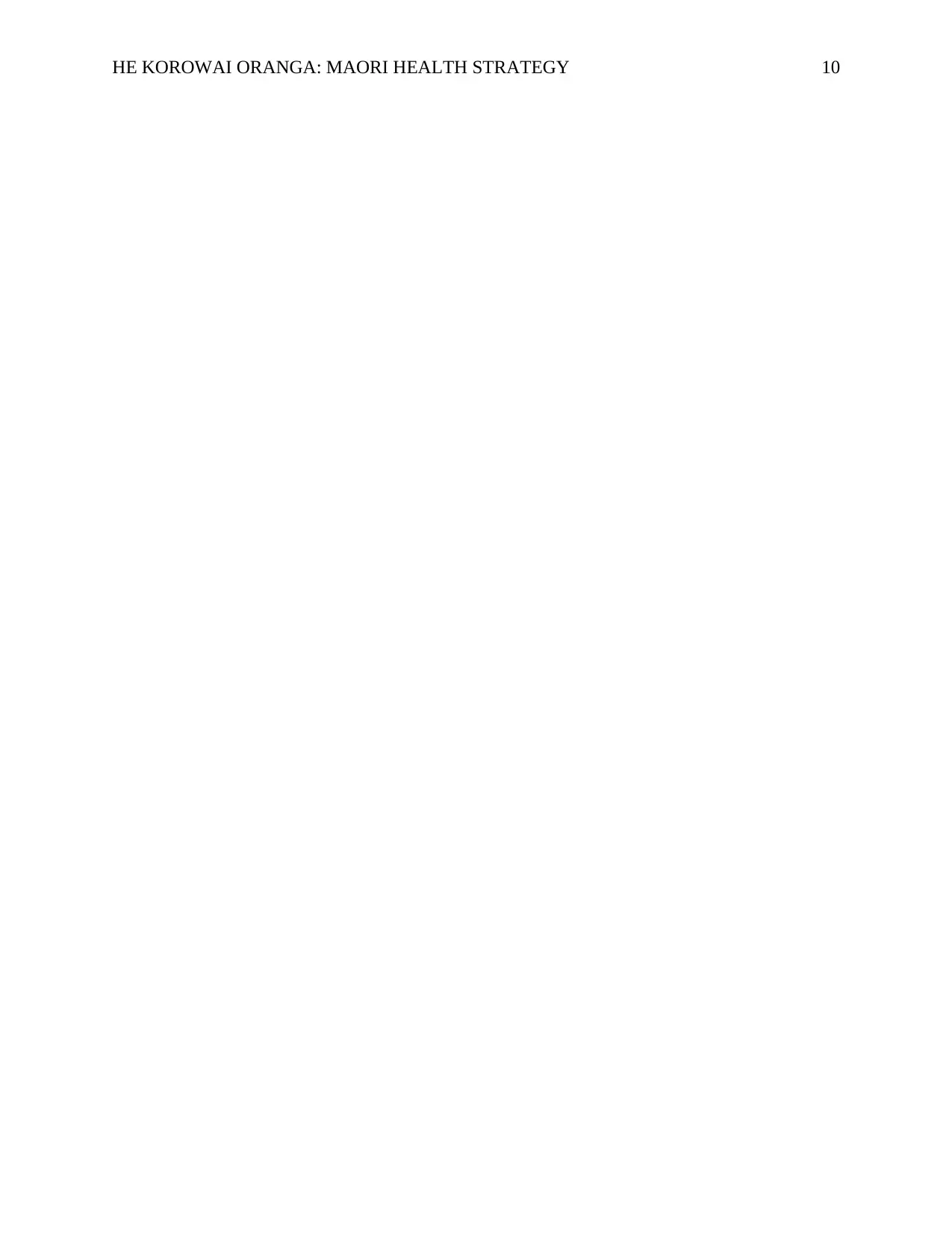
HE KOROWAI ORANGA: MAORI HEALTH STRATEGY 10
Paraphrase This Document
Need a fresh take? Get an instant paraphrase of this document with our AI Paraphraser
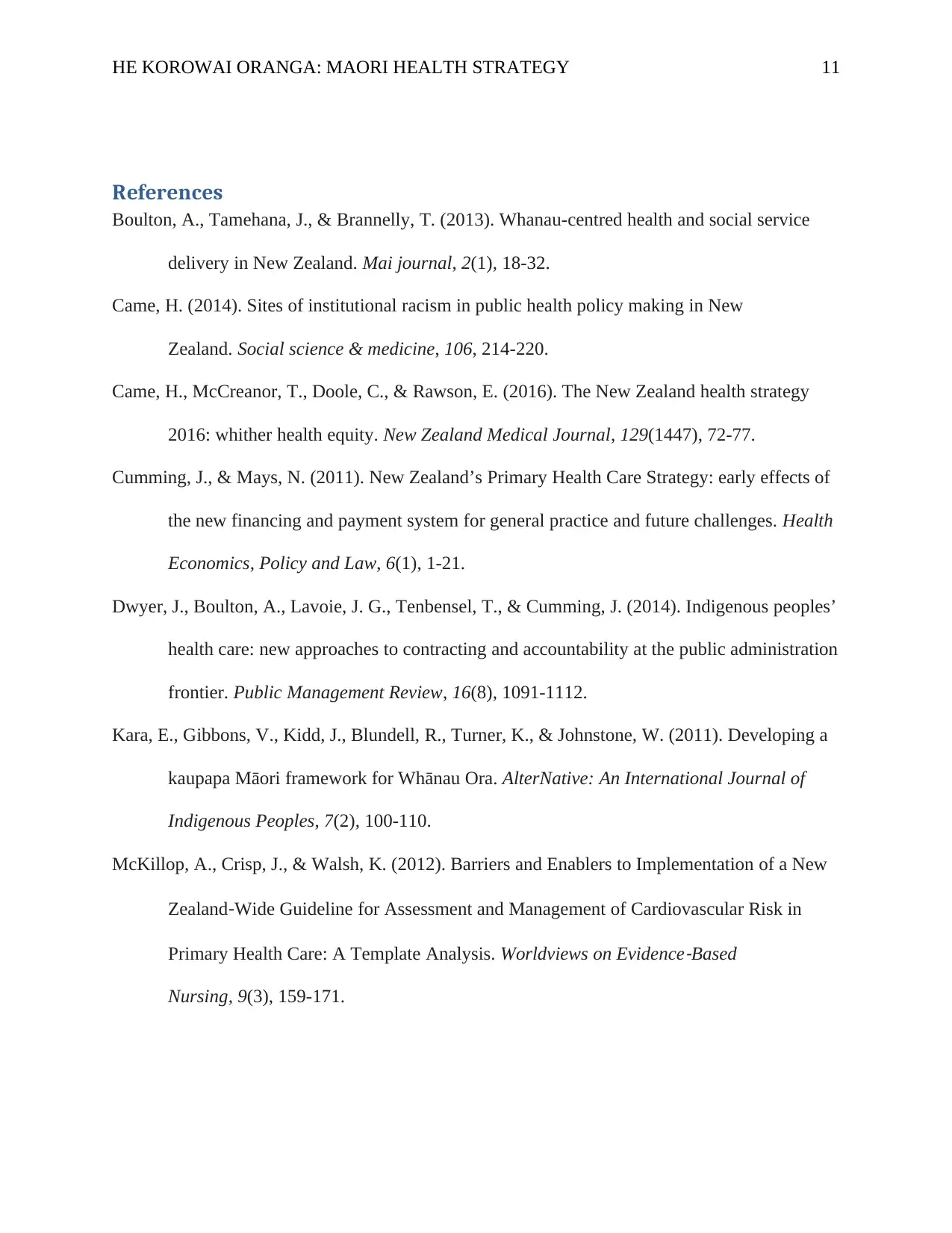
HE KOROWAI ORANGA: MAORI HEALTH STRATEGY 11
References
Boulton, A., Tamehana, J., & Brannelly, T. (2013). Whanau-centred health and social service
delivery in New Zealand. Mai journal, 2(1), 18-32.
Came, H. (2014). Sites of institutional racism in public health policy making in New
Zealand. Social science & medicine, 106, 214-220.
Came, H., McCreanor, T., Doole, C., & Rawson, E. (2016). The New Zealand health strategy
2016: whither health equity. New Zealand Medical Journal, 129(1447), 72-77.
Cumming, J., & Mays, N. (2011). New Zealand’s Primary Health Care Strategy: early effects of
the new financing and payment system for general practice and future challenges. Health
Economics, Policy and Law, 6(1), 1-21.
Dwyer, J., Boulton, A., Lavoie, J. G., Tenbensel, T., & Cumming, J. (2014). Indigenous peoples’
health care: new approaches to contracting and accountability at the public administration
frontier. Public Management Review, 16(8), 1091-1112.
Kara, E., Gibbons, V., Kidd, J., Blundell, R., Turner, K., & Johnstone, W. (2011). Developing a
kaupapa Māori framework for Whānau Ora. AlterNative: An International Journal of
Indigenous Peoples, 7(2), 100-110.
McKillop, A., Crisp, J., & Walsh, K. (2012). Barriers and Enablers to Implementation of a New
Zealand‐Wide Guideline for Assessment and Management of Cardiovascular Risk in
Primary Health Care: A Template Analysis. Worldviews on Evidence
‐Based
Nursing, 9(3), 159-171.
References
Boulton, A., Tamehana, J., & Brannelly, T. (2013). Whanau-centred health and social service
delivery in New Zealand. Mai journal, 2(1), 18-32.
Came, H. (2014). Sites of institutional racism in public health policy making in New
Zealand. Social science & medicine, 106, 214-220.
Came, H., McCreanor, T., Doole, C., & Rawson, E. (2016). The New Zealand health strategy
2016: whither health equity. New Zealand Medical Journal, 129(1447), 72-77.
Cumming, J., & Mays, N. (2011). New Zealand’s Primary Health Care Strategy: early effects of
the new financing and payment system for general practice and future challenges. Health
Economics, Policy and Law, 6(1), 1-21.
Dwyer, J., Boulton, A., Lavoie, J. G., Tenbensel, T., & Cumming, J. (2014). Indigenous peoples’
health care: new approaches to contracting and accountability at the public administration
frontier. Public Management Review, 16(8), 1091-1112.
Kara, E., Gibbons, V., Kidd, J., Blundell, R., Turner, K., & Johnstone, W. (2011). Developing a
kaupapa Māori framework for Whānau Ora. AlterNative: An International Journal of
Indigenous Peoples, 7(2), 100-110.
McKillop, A., Crisp, J., & Walsh, K. (2012). Barriers and Enablers to Implementation of a New
Zealand‐Wide Guideline for Assessment and Management of Cardiovascular Risk in
Primary Health Care: A Template Analysis. Worldviews on Evidence
‐Based
Nursing, 9(3), 159-171.
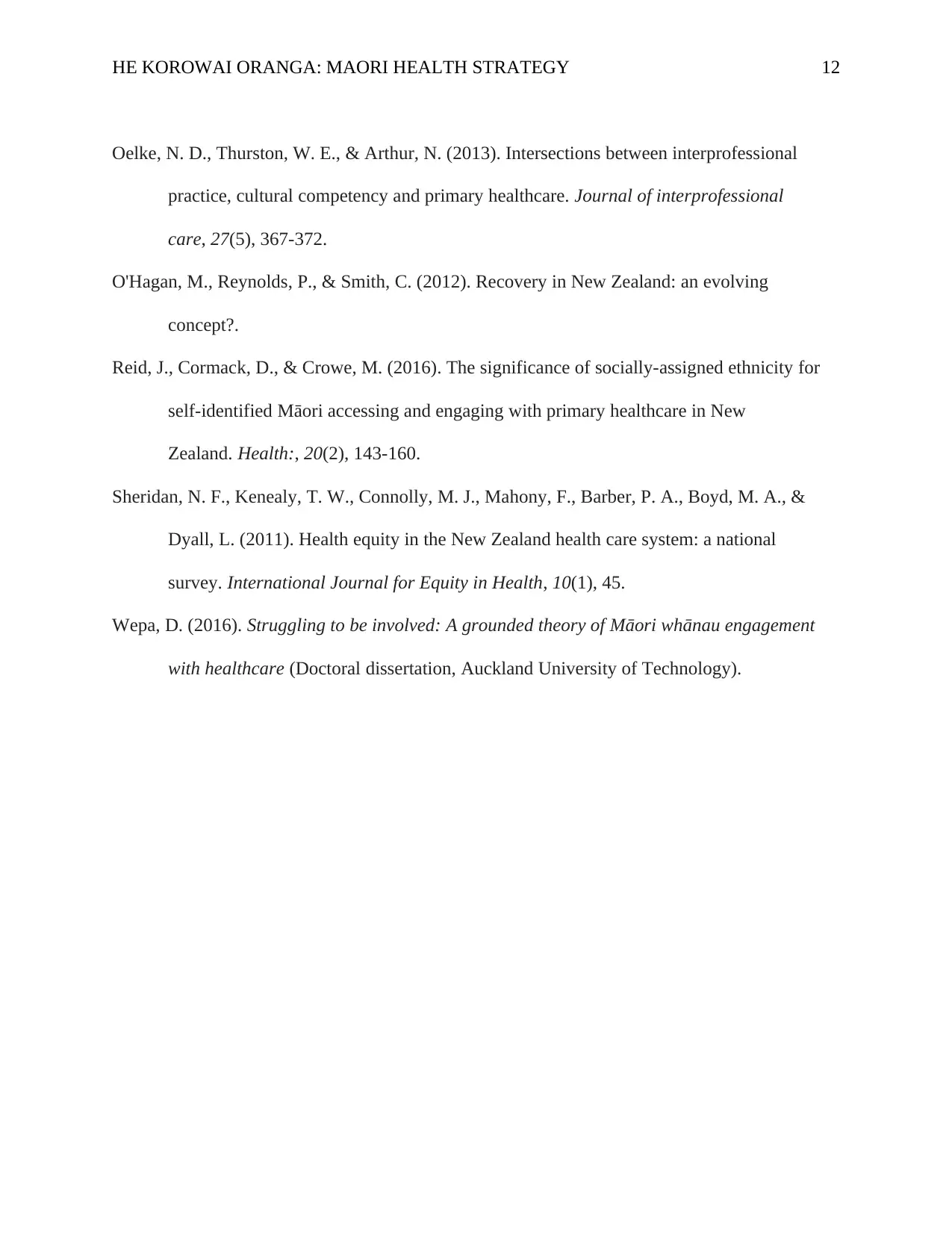
HE KOROWAI ORANGA: MAORI HEALTH STRATEGY 12
Oelke, N. D., Thurston, W. E., & Arthur, N. (2013). Intersections between interprofessional
practice, cultural competency and primary healthcare. Journal of interprofessional
care, 27(5), 367-372.
O'Hagan, M., Reynolds, P., & Smith, C. (2012). Recovery in New Zealand: an evolving
concept?.
Reid, J., Cormack, D., & Crowe, M. (2016). The significance of socially-assigned ethnicity for
self-identified Māori accessing and engaging with primary healthcare in New
Zealand. Health:, 20(2), 143-160.
Sheridan, N. F., Kenealy, T. W., Connolly, M. J., Mahony, F., Barber, P. A., Boyd, M. A., &
Dyall, L. (2011). Health equity in the New Zealand health care system: a national
survey. International Journal for Equity in Health, 10(1), 45.
Wepa, D. (2016). Struggling to be involved: A grounded theory of Māori whānau engagement
with healthcare (Doctoral dissertation, Auckland University of Technology).
Oelke, N. D., Thurston, W. E., & Arthur, N. (2013). Intersections between interprofessional
practice, cultural competency and primary healthcare. Journal of interprofessional
care, 27(5), 367-372.
O'Hagan, M., Reynolds, P., & Smith, C. (2012). Recovery in New Zealand: an evolving
concept?.
Reid, J., Cormack, D., & Crowe, M. (2016). The significance of socially-assigned ethnicity for
self-identified Māori accessing and engaging with primary healthcare in New
Zealand. Health:, 20(2), 143-160.
Sheridan, N. F., Kenealy, T. W., Connolly, M. J., Mahony, F., Barber, P. A., Boyd, M. A., &
Dyall, L. (2011). Health equity in the New Zealand health care system: a national
survey. International Journal for Equity in Health, 10(1), 45.
Wepa, D. (2016). Struggling to be involved: A grounded theory of Māori whānau engagement
with healthcare (Doctoral dissertation, Auckland University of Technology).
⊘ This is a preview!⊘
Do you want full access?
Subscribe today to unlock all pages.

Trusted by 1+ million students worldwide
1 out of 12
Related Documents
Your All-in-One AI-Powered Toolkit for Academic Success.
+13062052269
info@desklib.com
Available 24*7 on WhatsApp / Email
![[object Object]](/_next/static/media/star-bottom.7253800d.svg)
Unlock your academic potential
Copyright © 2020–2025 A2Z Services. All Rights Reserved. Developed and managed by ZUCOL.





